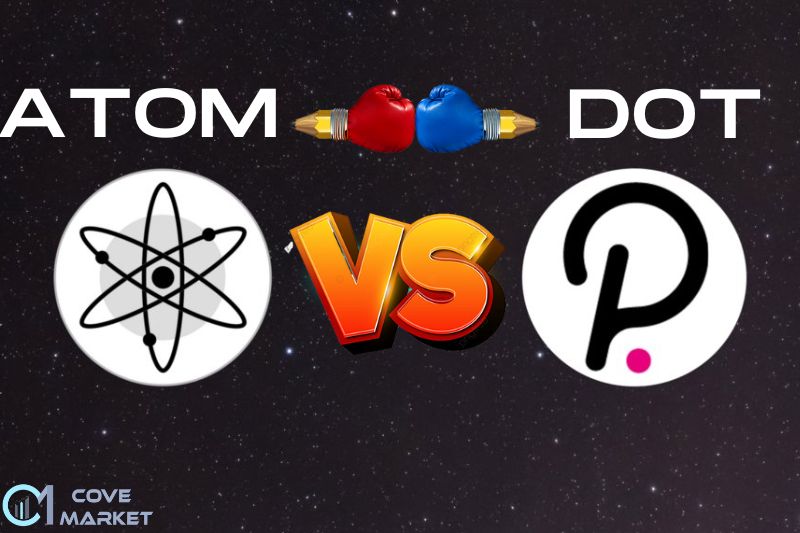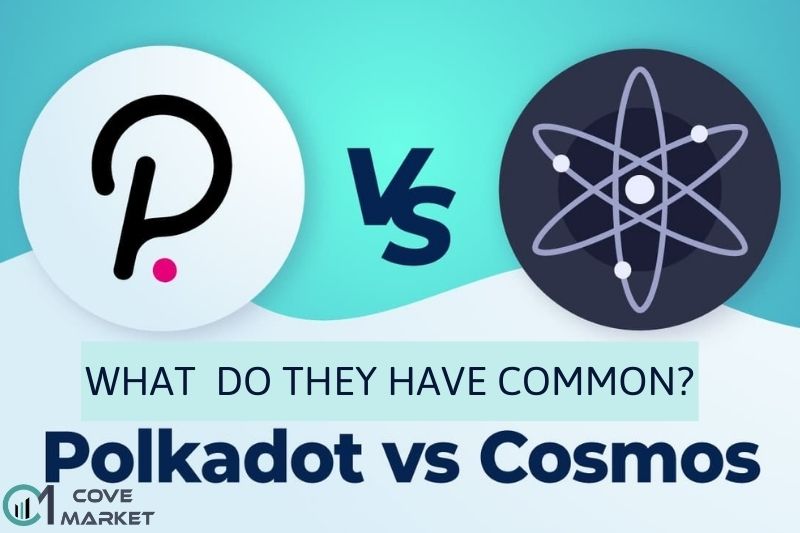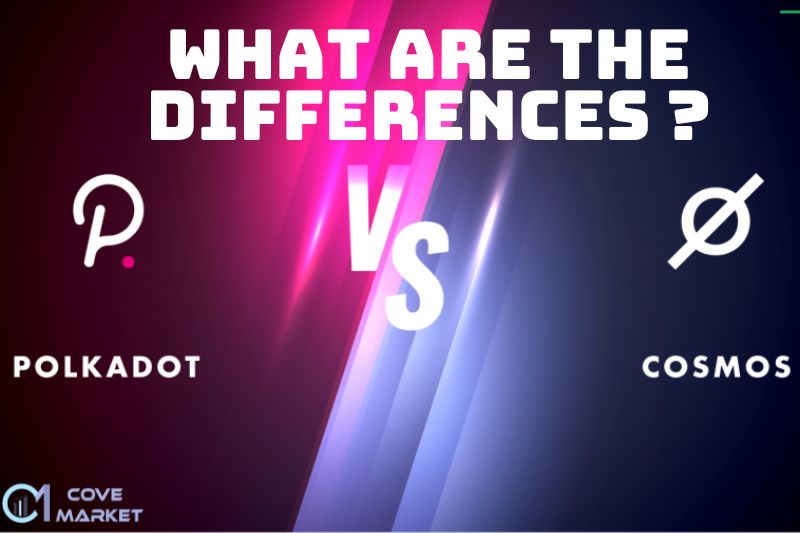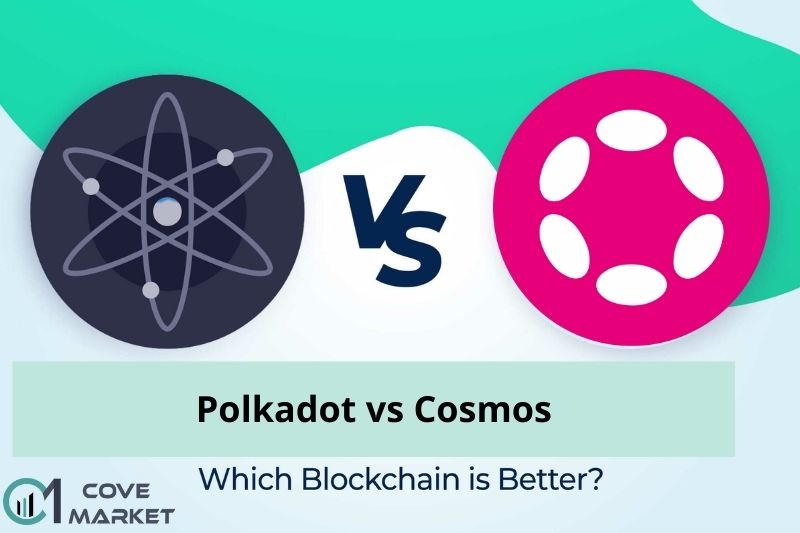One could decide to invest in the Cosmos cryptocurrency coin (ATOM) or the Polkadot token to have exposure to these businesses (DOT). So, Polkadot vs Cosmos, which currency offers the most potential returns for investors, and how do they operate? In this post, Covemarkets evaluate the performances of the two cryptocurrencies Cosmos and Polkadot?
Overview

What Is a Crypto Ecosystem?
Similar to this, the cryptographic ecosystem is a collection of numerous products that interact with and support one another within a Blockchain.
What’s Unique About Polkadot?
Polkadot has a few distinctive features.
- Scalability: The sharding approach, which processes multiple transactions at once, solves the sequential transaction processing issues on individual chains like Ethereum.
- Upgradeability: A blockchain must occasionally fork to upgrade, which takes time and effort. Another issue with hard forks is that the entire community must make decisions. The Polkadot network enables blockchains to update without needing a chain fork.
- Composability Across Chains: Polkadot supports cross-chain communication. Messages can be sent across segments to facilitate communication, value exchange, and functionality sharing.
What’s Unique About Cosmos?
Cosmos is not a product, but rather an ecosystem made up of a variety of flexible.
- Scalability: The first restriction is scaling; This is because Ethereum still relies on Proof-of-Work and its decentralized applications compete for the identical blockchain’s finite resources.
- Usability: The second restriction is developers’ limited degree of freedom. The EVM optimizes for the typical use case because it is a sandbox and must support all use cases. As a result, developers must compromise on the application’s efficiency and design
- Sovereignty: In essence, this creates two levels of governance: one for the application and one for the underlying environment. The latter restricts the former.
Advantages vs. Disadvantages
Polkadot
Advantages:
- The Substrate modular architecture from Parity Technologies gives programmers the freedom to pick and choose the components that best suit their application-specific chain.
- Using a shared security paradigm, Polkadot enables developers to establish chains and applications without worrying about finding enough miners or validators to protect their own chains.
- Bridges can be used by Polkadot’s parachains to link to outside networks like Bitcoin and Ethereum.
- Already a top ten currency by market cap, Polkadot has raised close to $200 million and begun to interact with other networks
Disadvantages:
- Polkadot is in competition with numerous other general-purpose, Proof of Stake, smart contracts blockchains, like Tezos, Cosmos, and Cardano, to mention a few, while Ethereum, the market leader, has already demonstrated persistent network effects.
- Hackers have twice taken advantage of coding flaws to steal millions of dollars before being stopped.
- There are only a few parachains available, and slots are sold through an auction, which may make certain minor use cases unaffordable.
Read more: Comparison of Two Blockchain Consensus Algorithms: PoW Vs PoS: Which Is Better For You 2023
Cosmos
Advantages:
- The Cosmos network has connected with notable blockchains and decentralized applications (dApps) with wide acceptance, like Binance Chain and dyDx. The network manages assets worth about $150 billion, and there are about 290 apps (as of Q2 2023).
- It is quite simple for developers to switch over to Cosmos thanks to the Cosmos Software Development Kit (SDK), a modular architecture that makes it easier to build safe blockchain apps on top of the Tendermint consensus process.
- Projects and developers wishing to build their own blockchains will have even more flexibility, freedom, and incentives to join Cosmos as a result of plans to implement an opt-in shared security model within network zones.
Disadvantages:
- Cosmos is up against tough opposition from a variety of directions. While Ethereum is the leader in the ecosystem for DeFi, NFTs, DAOs, and more, Polkadot is a direct rival with strong brand recognition.
- Until there are explicit statements to the contrary, regulatory worries will always exist because of its ICO. On the other hand, the SEC has previously remarked (twice) on rival blockchain Ethereum and stated that they do not think it meets the definition of security.
Read more: IDO Vs ICO Vs IEO: What Is An IDO In Crypto And How To Invest It 2023?
What Do They Have in Common?

- Both the Cosmos and Polkadot protocols seek to build interconnected blockchain networks that will allow the decentralized Web3 to scale. Tthe Polkadot Relay Chain transmits messages between parachains.
- Polkadot and Cosmos are both regarded as Layer 0 networks since they enable interoperability. Layer 0 networks allow Layer 1 blockchains like Ethereum and Bitcoin to operate on the same network, whilst Layer 2 protocols provide improvements like scalability and quicker processing rates.
Polkadot Vs Cosmos: What Are The Differences Between 2 Ecosystems?

Here are some information about the difference between 2 ecosystems:
Mechanism
Polkadot
- Polkadot uses an NPoS (Nominated Proof-of-Stake) technique. Data calculation and transaction information processing, which keep networks connected, are mostly handled by Parachain.
- In essence, this approach chooses the validators based on their DOT staking in an effort to maximize chain security.
- Polkadot functions as a vast network of numerous interoperable independent blockchains. However, in Cosmos, every blockchain is totally independent of the others and has its own validators and consensus.
Cosmos
- One of the blockchain 3.0 technologies, Cosmos, makes it simpler for programmers to create blockchains that can communicate with one another without compromising sovereignty, speed, or interoperability.
- Tendermint includes networking and consensus, allowing developers to concentrate more on creating use cases than on figuring out the technology. Developers can spend less time writing needless code.
Programming language
- Polkadot: Rust is the programming language on which it is based.
- Cosmos : Programmers in the Golang programming language
Technology
Polkadot
The Polkadot architecture allows developers to build their own blockchains with a bigger design area for decentralized assets and apps. Three key advantages exist between creating your product as a set of smart contracts versus building it on a personalized blockchain.
Performance is improved by separating the customized blockchain from other chains. It is not slowed down by other network traffic.
The Polkadot network’s high transaction risk is reduced. High costs are one of the barriers to adopting permissionless networks, hence this is essential for widespread adoption.
Cosmos
The Tendermint BFT Engine is one of the best aspects of the Cosmos network. This incredibly potent technique enables blockchain engineers to add new zones to the network without having to code them from scratch.
The Tendermint Core, the blockchain’s central processing unit, powers the whole network. The system’s transaction validators, or nodes, are managed and controlled via the Proof of Stake consensus process.
All of these validator nodes must vote in favor of the proposed modification whenever it is put out within the network. Having an ATOM cryptocurrency stake is the only need for transaction validator status.
Decentralization
Polkadot
- Polkadot does not depend on a single entity for operation, making it more decentralized than other protocols. Instead, it depends on a network of validators who are in charge of confirming transactions and preserving the safety of the network.
- Additionally, because it can connect to several kinds of blockchains, Polkadot is intended to be more adaptable than existing protocols. This indicates that it can be utilized for a wide range of applications, including supply chain management, IoT, and financial services.
Cosmos
Blockchains can be conceptually separated into three layers:
- Application: In charge of processing transactions and changing the state given a collection of transactions.
- Networking: In charge of spreading communications pertaining to transactions and consensus.
- Consensus: Allows nodes to concur on the system’s present state.
Downtimes
Polkadot
Polkadot has experienced four big outages as of July 2020.
- On May 28, 2020, a hacker used a software flaw to steal DOT tokens valued at $1.2 million from a smart contract on the Kusama network.
- A hacker exploited a software flaw on June 19, 2020, to steal $146,000 worth of DOT tokens from a smart contract on the Polkadot network.
- A software error on July 21, 2020, led to a fork in the Polkadot network, which resulted in the loss of nearly $4 million in DOT tokens.
- A software error on September 21, 2020, led to a fork in the Polkadot network, which resulted in the loss of nearly $30 million in DOT tokens.
Cosmos
On the morning of July 9, 2023, Osmosis DEX on Cosmos (ATOM) was temporarily suspended after discovering an incident that caused a loss of 5 million USD.
Osmosis Zone discovered a critical flaw in the user reward mechanism that provides liquidity at the protocol’s pools.
Transaction cost (Gas fees)
- Polkadot: has a transaction fee of 0.05 DOT.
- Cosmos: there is a transaction fee of 2.85% for each transaction.
The third-party processor, not COSMOS, is the one who levies the transaction fee, which is non-refundable regardless of whether the payment it corresponds to is canceled, refunded, credited, or charged back.
Transaction speed
Polkadot
The block time of the underlying blockchain determines how quickly transactions go through Polkadot. Polkadot transactions, for instance, would be validated once every second if they were based on a blockchain with a one-second block duration.
Compared to Bitcoin or Ethereum, Polkadot has a substantially faster transaction rate. Around 1,000 transactions can be handled per second by Polkadot.
Cosmos
The Tendermint Core consensus engine, on which Cosmos is built, allows for a theoretical maximum of 10,000 transactions per block (see Tendermint’s blog post on A-to-Z of Blockchain Consensus).
However, according to Paradigm’s write-up and study, the throughput lowers to 4,000 TPS with 64 validators.
Network size
Polkadot
The size of the Polkadot network is not yet known, as it is still in development. However, it is estimated that when the network is fully operational, it will consist of around 100 validators and 10,000 nodes.
Cosmos
There are 175 validators at the Cosmos Hub, but more can be added over time with governance proposals. The top 175 validator candidates with the most voting power are the current Cosmos validators.
The validators are chosen based on the total number of ATOM tokens assigned to them.In order to maintain consensus, Cosmos uses a network of 100 validator nodes.
Scalability
Polkadot
- By allowing many parachains to operate concurrently through a single relay chain, each parachain can process numerous transactions in parallel, which is how Polkadot is intended to eliminate these bottlenecks.
- The scalability of that system would be around 100 times greater than that of a current Proof of Stake system if dozens of blockchains could operate simultaneously.
- Potentially, several relay chains connected to the root relay chain in a subsequent version of Polkadot could increase scalability by 1000x to 10,000x over a present PoS system.
Cosmos
- Vertical scaling: Tendermint BFT can achieve thousands of transactions per second by eschewing Proof-of-Work and improving its constituent parts.
- Horizontal scalability: No matter how well-optimized the consensus engine and the application are, a single chain’s transaction throughput will eventually reach a limit that it cannot cross.
- The maximum vertical scaling is at that point. Blockchains would theoretically be infinitely scalable if several parallel chains were operating the same application under the control of a single validator set.
Market cap
| Polkadot | Cosmos | |
| Market Cap (USD) Rank Volume (24h) Circulating supply Total supply | 8,211,458,400 11 $267,940,051 1.11B DOT 1,227,712,960 | 3,392,237,603 23 $333,173,357 286,370,297.00 ATOM N/A |
DeFi ecosystem
Polkadot
- A decentralized platform called Kusama is used to start young Polkadot projects. KSM, its native coin, now has a market cap of $755.5 million.
- Ankr: This innovative decentralized platform offers a multichain toolbox for accessing web3 infrastructure. Its native token, ANKR, now has a market cap of $305.4 million.
- The most well-known decentralized Polkadot launchpad, Polkastarter, also supports Ethereum, BNB Chain, Solana, Polygon, Avalanche, and Celo. Its current native token, POLS, has a market cap of $68.1 million.
- Projects are tested in Moonriver before being implemented in Moonbeam, making it a complementary company to Moonbeam. Its native coin, MOVR, currently has a market cap of $98.1 million.
Read more: TOP Polkadot Projects To Know In 2023: DeFi, P2P, NFTs, Metaverse
Cosmos
- Cronos: The location of crypto.com, the second-largest centralized exchange in the world. Its native token, CRO, currently has a market cap of $5.5 billion.
- Anchor: Terra’s largest DeFi protocol. Its native token, ANC, currently has a market cap of $90.4 million.
- An extremely well-liked DeFi protocol, THORChain has $3.2 billion in native on-chain swaps and more than $558 million in TVL.
- KAVA: A highly quick layer 1 blockchain that combines the permissionless ecosystems of Cosmos and Ethereum. Its native token, KAVA, now has a market cap of $395.1 million.
NFTs
Polkadot
The Polkadot team will develop the first NFTs on the platform. The DOT tokens that are used to stake and validate the network will be represented by these NFTs. The NFTs will be used to represent the DOT tokens, which will be kept on a Parachain.
The DOT tokens will be able to be traded on any blockchain that supports the PVS as a result. In addition, the Polkadot team is developing a standard for building NFTs that represent various assets, including fiat money, digital assets, and potentially physical assets.
Cosmos
The first non-fungible tokens (NFTs) to function natively on Cosmos is Cudos, a decentralized cloud computing network.
They would have direct access to mint, authorize, transfer, and burn funds. Since they won’t need to run on the Wasm VM, all of these transactions will be considerably less expensive.
Cudos incorporates transactions for asset migration to other chains, like Ethereum, into the Gravity Bridge. In order for other Cosmos chains to eventually profit as well, the decentralized cloud network plans to open-source all the code.
At a Glance
| Polkadot | Cosmos | |
| Native coin | DOT | ATOM |
| What is it? | Interchain Network | Interoperable Blockchain Hub |
| Market cap | $8.2 Billion | $3.4 Billion |
| Number of validators | 297 | 150 |
| Bottom line | More decentralized | Faster & more user friendly |
| Founders | Gavin Wood, former Co-Founder and CTO of Ethereum | Jae Kwon ,Zarko Milosevic and Ethan Buchman |
| All-Time Low | $2.69 166.69% on Aug 20, 2020 (2 years ago) | $1.13 837.60% on Mar 13, 2020 (2 years ago) |
| All-Time High | $55.00 86.94% on Nov 04, 2021 (10 months ago) | $44.70 76.28% on Sep 20, 2021, |
Potential Projects
On Polkadot
- Acala is a bit like Astar Network in that it wants to develop a defi hub. An application that end consumers will use to invest on Polkadot.
- Polkadot Parachain Auction: Investors will lock DOT into the project they want to win the auction. Investors can participate in many ways, using the Polkadot.js wallet or the centralized exchange Binance.
- Moonbeam: aims to be one of the first Parachains on Polkadot and possibly one of the most important pieces. Moonbeam will be part of a smart contract platform allowing developers to build and interact with smart contracts on Polkadot.
- Astar Network : is a dapp hub and well sourced. Is the Polkadot version of the Shiden Network that has been launched on the Polkadots Kusama testnet.
On Cosmos
- Iris Network: A cross-chain vendor hub for next-generation DApps, built on Cosmos-SDK, IRIS Hub enables cross-chain interoperability and produces Modules to support DeFi.
- Persistence: An ecosystem of financial products, for both retail investors and large credit institutions.
- Sentinel: A network layer that produces P2P, decentralized applications, and marketplace.
- Osmosis: The first AMM on Cosmos Hub, with massive Volume and TVL growth coming soon.
DOT vs ATOM: Which Is a Better Investment?

To be honest; as of right now, I would probably vote for Cosmos if I had to choose only one blockchain. It is primarily because it currently offers more usefulness due to the fact that anyone can develop projects on the network.
Polkadot, though, will be widely watched because it provides significantly more security and can more readily address the interoperability issue.
Where to buy DOT and ATOM?

One of the most well-liked coins in the cryptocurrency space are ATOM and DOT. On a number of exchanges, including Binance, Gate.io, Uphold, Coinbase, KuCoin, BitYard, and Huobi Global, Covemarkets may purchase it.
Read more:
- Coinbase vs Binance: Which Crypto Exchange is Best?
- Coinbase vs Kraken: A Breakdown for Active Cryptocurrency Traders
FAQs
Which one should I choose?
Polkadot may be more suited for those who are looking for a more scalable solution, while Cosmos may be more appropriate for those who are looking for a more customizable platform.
Which one is the best ecosystem?
Depending on your tastes and level of risk tolerance, your study may help Covemarkets choose which project is the better one.
Is Polkadot more secure than Cosmos?
Polkadot is more secure than Cosmos in terms of its consensus mechanism and overall network design. Polkadot uses a Proof-of-Stake (PoS) consensus algorithm, which is more secure than the Proof-of-Work (PoW) consensus algorithm used by Cosmos.
Which is more advanced?
Currently, Polkadot is more valuable than Cosmos. Therefore, it will be interesting to observe which initiative can address the interoperability problem first and clear the way for widespread use of cryptocurrencies.
Is Polkadot or Cosmos more popular?
There is no definitive answer to this question as both Polkadot and Cosmos are popular in different ways. Polkadot is popular for its unique features and flexibility, while Cosmos is popular for its stability and interoperability.
Why are they so popular?
There are a few reasons for this.
- First, they offer a very high degree of security and scalability.
- Second, they are very user friendly and have a lot of features that make them attractive to users
Where can I learn more about them?
Covemarkets can supply more information about Polkadot and Cosmos or you can look up on their official website.
Conclusion
Despite their differences, both platforms seek to offer a quick, affordable, and scalable substitute for Ethereum, the leading innovative contract blockchain. Furthermore, by utilizing PoS consensus rather than the power-intensive PoW consensus, Cosmos and Polkadot are contributing to lowering the carbon footprint of the blockchain sector.
In conclusion, Covemarkets should have a comprehensive understanding of the main distinctions between these two prominent cross-chain blockchain networks after reading this essay on “Polkadot vs. Cosmos.”
Disclaimer: The information provided in this article is not investment advice from Cove Markets. Cryptocurrency investment activities are yet to be recognized and protected by the laws in some countries. Cryptocurrencies always contain financial risks.
Best Crypto Exchanges For Trading In 2023: Centralized Exchanges
Polkadot Vs Solana: DOT Vs SOL. Which Crypto Is Better In 2023
TOP 10 Best Blockchain Solutions & Its Use Cases In 2023: What Are The Benefits

